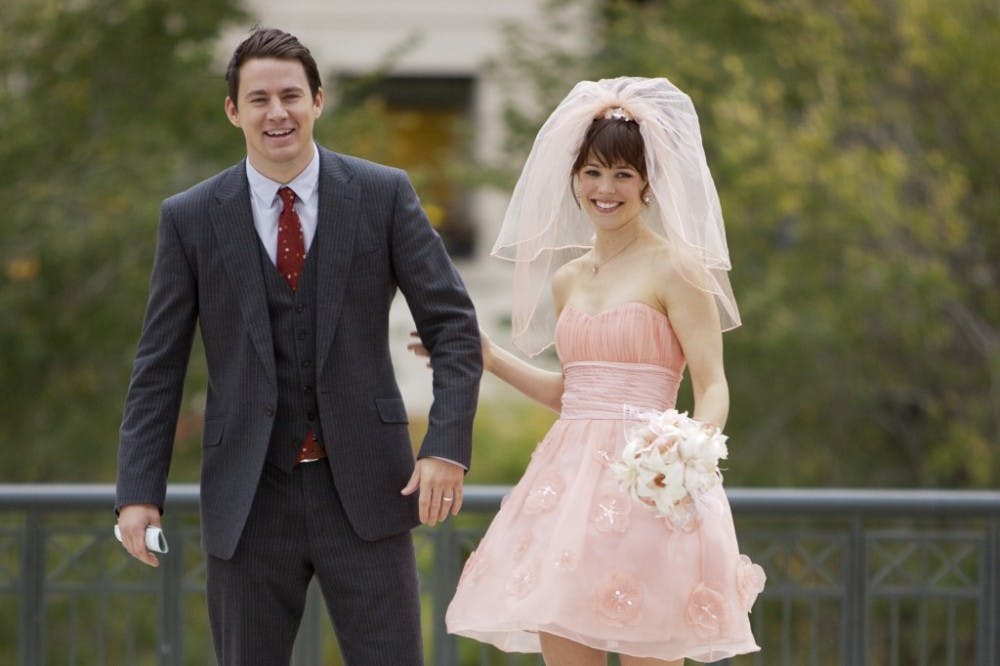My planner has had a tiny heart in the bottom-right corner of the Feb. 10, 2012 page for almost a month now. Was Feb. 10 my birthday, you ask? No. An anniversary? No. It was the date “The Vow” was released to theaters nationwide (go ahead, laugh).
While obviously, as a female, my heart swoons over Channing Tatum’s dashing physique and adorable charm, I’m also an avid fan of what most call “chick flicks.”
Since I’ve been old enough to watch movies other than animated Disney features, I’ve been fairly familiar with the term “chick flick." Wikipedia defines the chick flick as “a film mainly dealing with love and romance designed to appeal to a female target audience." Wikipedia also said these so-called chick flicks are released "en-masse" around Valentine’s Day (perfect example: “The Vow”).
This being a fairly generic definition, I was motivated to create my own criteria for what warrants a movie the title of “chick flick.”
My personal understanding of what qualifies a film as a “chick flick” has several features:
There must be a romantic element.
This one is obvious. The entire plot of a chick flick usually revolves around a romance that was, is or will be. Even if the romance is not evident at the start of a movie, most of the plot events in said chick flick are likely building up to it or hinting at its creation. There is some clarification with this rule, however. Not all movies with a romantic element are chick flicks. For example, in “Transformers,” Shia LaBeouf somehow lands the bombshell that is Megan Fox as his significant other. This romance, however, does not mean “Transformers” is a chick flick. With its incredibly lengthy fight scenes, it is quite the contrary. A chick flick features a romantic element and at least two or three of my other defined qualifications.
A couple is brought together through unique circumstances.
What these circumstances are, is up to interpretation. These circumstances can be anything from a meet-up at the grocery store check-out (Scarlett Johansson and Bradley Cooper in “He’s Just Not That Into You”) to a hooker meeting... ya know... with her male client (“Pretty Woman”). In recent years, chick flicks have tended to bring together two characters who at first have extreme disdain for each other. For example, see Cameron Diaz and Ashton Kutcher in “What Happens in Vegas,” Tom Hanks and Meg Ryan in “You’ve Got Mail” (I know this one’s a little older) and basically every Katherine Heigl movie released in the past five years.
An abundance of cutesy love montages set to a pop song.
While no one has mastered this movie technique quite like Mary-Kate and Ashley Olsen in their “movies," it appears in almost every chick flick ever released. Seriously. I challenge you to watch any romance-centric movie you have on hand. Likely following a scene or two after a couple finally gets together or acknowledges their attraction, there will be a montage. It often involves the couple doing activities ranging from a romantic bike ride, sharing a meal, taking silly photographs, walking down the street holding hands and even cuddling! Topped off with whatever the most recent hit pop song on the market is, this scene seems to be a go-to for filmmakers. A relative of this montage is the fashion show/clothing montage (see the bridesmaid-dress fashion parade in “27 Dresses”).
An untimely breakup or falling out.
This tragedy usually occurs toward the middle or end of the movie (though some buck this format, like “Crazy, Stupid, Love.” which starts the movie off with a bang). It often stems from something stupid that one of the characters has done, said or, most often, lied about. For chick flick first-timers, this may seem like the end for the couple. But never fear, it’s just the road bump filmmakers throw in so they can ultimately add that huge romantic gesture that gets them back together and makes you go “Aww!”
A sappy-ending including some version of a wedding, kiss, “I love you!” or even a hug.
As I previously mentioned, I’m quite sappy and also a hopeless romantic. This qualification is the aspect of chick flicks I live for. Thus, I’m highly disappointed when the characters do something as ghastly as display their everlasting love through a hug. I want a “Say Anything”-style, boombox-over-the-head declaration of love. No matter how it happens, though, every chick flick features the sappy and almost-always-happy ending.
A theater filled predominantly with women (and their annoyed boyfriends).
This isn’t so much an aspect of the movie itself, but more so the audience it attracts. I mean, it’s called a chick flick for a reason. Chicks dig ‘em. This isn’t to say men can’t enjoy chick flicks — I’ve had numerous men tell me they cried at “The Notebook.” Men can appreciate a romantic film, they just aren’t as likely as women are to admit they loved “Atonement."
While obviously the chick flick genre has many more encompassing features, these are the basic criteria, in my opinion, that define the film format. There’s a slew of intriguing new chick flicks coming out in the next few months. Don’t worry, I’ll be in the movie theater watching.


